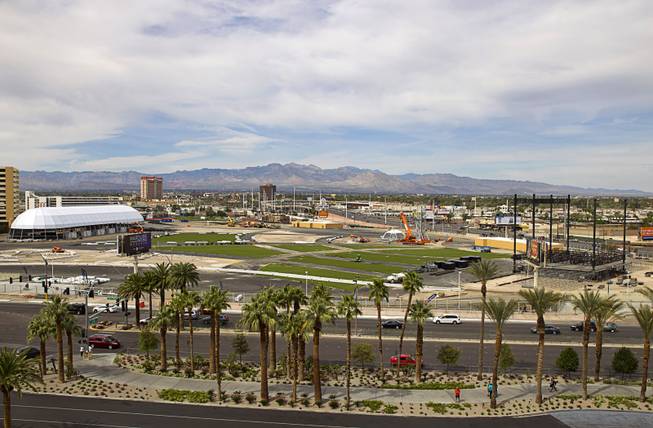
The Las Vegas Festival Ground is shown during setup for the Rock in Rio musical event at Las Vegas Boulevard and Sahara Avenue Sunday, March 22, 2015.
Friday, July 23, 2021 | 2 a.m.
Oakland A’s leadership have visited numerous sites throughout Southern Nevada in recent weeks to explore potential relocation here.
This week, the club brought architect Brad Schrock in an effort to visualize which sites would potentially be best. More than 20 sites here are being considered.
It’s safe to say a few stood out, namely Phil Ruffin’s Las Vegas Festival Grounds land near Las Vegas Boulevard and Sahara Avenue, and a site in Summerlin.
“On the north Strip at the Festival Grounds, to have that view back down the entire Strip, that would be pretty iconic,” A’s president Dave Kaval said. “In Summerlin, if a ballpark site could look over the entire valley … wow. That would be dynamic. Those two sites stood out, but there’s a lot of locations, including west of Interstate 15 and also in Henderson.”
The midweek trip came after the Oakland City Council this week approved a term sheet for a ballpark and land development proposal that would lead to a $1 billion new home for the A’s. Yet, it’s unclear if the vote will be enough to keep the baseball team at the negotiating table instead of leaving the San Francisco Bay Area city.
The vote was the latest step in a process by which city leaders and officials from the A’s have tried to hammer out a deal for a waterfront ballpark to get the Major League Baseball team to stay put. The 6-1 vote backed the proposal that requires the development to include affordable housing, tenant protections and environmental measures.
But Kaval said the financial terms do not work for the team, and continued with the aggressive pursuit in Las Vegas.
“It was another fun trip because it’s an exciting process to understand how we could approach a stadium and how the roof could open,” Kaval said. “We got a little more knowledge about how stadiums could be laid out on some of these sites as we continue our process here in Southern Nevada.”
The process Kaval speaks of is what team officials are calling a “parallel path” plan to find a new ballpark for the team, which would replace the aging RingCentral Coliseum in Oakland.
That stadium, also formerly home to the NFL’s Las Vegas Raiders, has been the A’s home since the team moved to Oakland from Kansas City in 1968.
As time continues and the A’s and Major League Baseball seemingly become more frustrated with a perceived lack of progress in Oakland — the A’s have unsuccessfully tried for years to get a new stadium — it could be a chance for leaders in the Las Vegas Valley to make a move to lure the team.
In a Wednesday statement, Major League Baseball Commissioner Rob Manfred said the A’s have “invested significant resources and have made a major commitment to their community in the hopes of remaining as Oakland’s only major professional sports franchise.”
He said baseball officials were “disappointed” with the Oakland City Council’s vote on Tuesday.
“We will immediately begin conversations with the A’s to chart a path forward for the club,” Manfred said.
Though it’s possible that other cities in the U.S. — and perhaps in Canada — could eventually be involved in talks with the A’s about a new ballpark, Kaval said only the waterfront site in Oakland and sites in Southern Nevada are being considered now.
Kaval said the A’s are still sifting through the details of the plan Oakland officials voted for on Tuesday, though he was adamant that it wasn’t a package the team had hoped for.
He said public officials and casino operators and owners in Southern Nevada have reached out to him in the days since the vote.
“We’re still unpacking what they voted on,” Kaval said. “It’s something we had never seen. It’s not our proposal. The timing is important, and we need to continue to work with MLB on that.”
Kaval said an A’s group will return to the area again in two weeks.
The elephant in the room on any A’s-to-Nevada talk is whether the team would ask for public monies for a new ballpark and, if so, how much.
“We need to learn more to continue to approach this in a thoughtful way,” Kaval said. “We don’t have all the answers right now. There’s so many people who care about these communities in Southern Nevada and want to see baseball here in a major way.”
